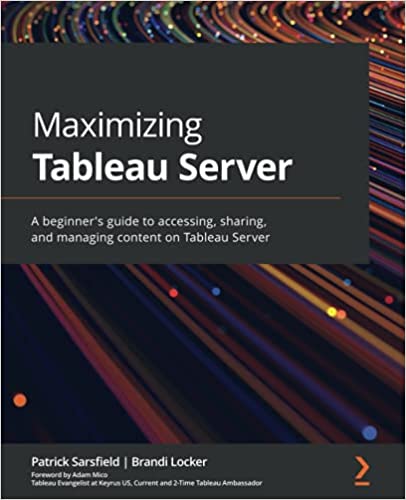Brandi Locker is the author of Maximizing Tableau Server we got the chance to sit down with him and find out more about his experience of writing with Packt.
Q: What is/are your specialist tech area(s)?
Brandi : Tableau Desktop, Tableau Server, Data Visualization, Figma
Q: How did you become an author for Packt? Tell us about your journey. What was your motivation for writing this book?
Brandi : My colleague, Pat Sarsfield, was contacted by a Packt representative to write a book about Tableau Server. Pat and I had collaborated on a number of projects previously, and he invited me to join him in this initiative. The topic was appealing to us because the book would provide a resource that we both wish we had when starting our careers. Tableau Server does not get the same attention that Tableau Desktop does, so there are not as many resources out there to help you leverage it effectively.
Q: What kind of research did you do, and how long did you spend researching before beginning the book?
Brandi : Our initial experience with Tableau Server came from hands-on experience at work. As we prepared for writing the book, we began exploring more of the features within Tableau Server and comparing our observations to the guides provided by Tableau. So many of the features we cover in this book are simple to utilize, but are often overlooked in the workplace. By nature, people tend to skim a page for whatever they are looking for in that moment, without stopping to explore what else is available. This book gave us the opportunity to examine and explain these features and some practical applications to Tableau Server users of all levels.
Q: Did you face any challenges during the writing process? How did you overcome them?
Brandi : I think one of the most challenging things was determining what to include and exclude from the book. For example, when discussing the Web Authoring feature, it was tempting to write more about creating data visualizations, but we chose to focus on what makes the Web Authoring feature unique from designing in Tableau Desktop. There are already a multitude of resources available on designing data visualizations, and we wanted to keep the focus of this book on Tableau Server features.
Q: What’s your take on the technologies discussed in the book? Where do you see these technologies heading in the future?
Brandi : Data is certainly here to stay, and I think that understanding how to leverage tools like Tableau Server can be instrumental in helping an organization to becoming more data-driven. Tableau Desktop allows individuals to visualize data, and Tableau Server facilitates the automation, distribution, and consumption of business insights observed in data.
Q: Why should readers choose this book over others already on the market? How would you differentiate your book from its competition?
Brandi : To my knowledge, there are few resources out there that discuss utilization of Tableau Server from a user’s perspective. The books discussing Tableau Server already on the market were written for a niche audience, like server administrators. Tableau Server end users generally have different questions and needs than administrators. While many excellent Tableau training materials exist, new users are not always certain where to look or what correct keywords to use in a search to find a solution to their problem. This book was an effort to consolidate information and provide a guide to the everyday user, including stakeholders/clients, analysts, and data visualization professionals.
Q. What are the key takeaways you want readers to come away from the book with?
Brandi : You can add immense value to your organization simply by gaining a better understanding of how to utilize Tableau Server effectively. For example, I have talked to many users who have never explored the Subscription feature in Tableau Server. They are usually very excited when I show them that they do not have to manually send out an email to their distribution group every day. Knowing the features available to you can save your organization time and money by automating routine tasks.
Q. What advice would you give to readers learning tech? Do you have any top tips?
Brandi : Always look for a better way of doing things. I have learned so much by questioning why or how something was being done and seeking to improve a product or process. Don’t underestimate the impact of small changes. Lastly, continually seek to improve your data literacy and your ability to interpret charts and graphs. Data is everywhere, and understanding how to interpret it pays off professionally and personally.
Q. Do you have a blog that readers can follow?
Brandi : No, but feel free to follow me on Tableau Public
Q. Can you share any blogs, websites and forums to help readers gain a holistic view of the tech they are learning?
Brandi : In the final chapter of our book, we offer a list of resources to help the reader continue learning about Tableau, data visualization, and data literacy. Among them, two of my favorite resources are “Storytelling with Data” by Cole Knaflic and “Avoiding Data Pitfalls” by Ben Jones.
Q. How would you describe your author journey with Packt? Would you recommend Packt to aspiring authors?
Brandi : The team at Packt was very patient with us while we learned how to manage our work and developed our writing style. Packt is really great at providing structure and guidelines, which is particularly helpful to new writers.
Q. Do you belong to any tech community groups?
Brandi : I co-lead the North Texas Tableau User Group and would highly encourage Tableau users to get involved with their local user group as well. It’s a great place to network with others and to grow in your knowledge of the software and data visualization as a whole.
Q. What are your favorite tech journals? How do you keep yourself up to date on tech?
Brandi : I keep up to date by staying involved with the Tableau community. So many individuals within the community are pushing the boundaries of what the different BI platforms can do and it’s inspiring to follow their work.
Q. How did you organize, plan, and prioritize your work and write the book?
Brandi : We had a few ideas to determine how the book should be structured, but the simplest method seemed to be introducing features within the Tableau Server interface in the order that you would most likely notice them on the screen, from top to bottom. During the planning phase, Packt instructed us on how to write a detailed outline. This outline became our guiding star throughout the book, and we adjusted it as necessary. Before writing each chapter, Pat & I planned who would write which sections, and then after writing our individual first drafts, we would send our content to each other to read before consolidating the entire chapter and submitting it for review by Packt editors. This allowed us to work at times that were best for us individually, but still maintain a cohesive flow to the book. It helped that we naturally have similar writing styles and workflows.
Q. What is that one writing tip that you found most crucial and would like to share with aspiring authors?
Brandi : Strive to be abundantly clear and explicit with your words. I found it particularly difficult to write about things that I personally perceive to be implicit, but everyone reads and interprets information differently. It could be confusing (and frustrating) to the reader to explain one technology feature thoroughly and to barely discuss another, just because you find it to be self-explanatory. Consistency helps the reader avoid distraction and understand what is being taught.
You can find Patrick’s & Brandi’s book on Amazon by following this link: Please click here









